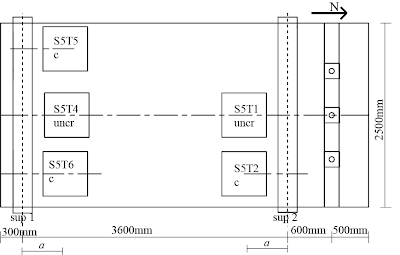Project #tweetprop: There is still life in “dead” slabs
The third proposition of my dissertation is the following:
The very large redistribution capacity of slabs is demonstrated, amongst others, by carrying out experiments on severely damaged and locally failed specimens that led, on average, to a capacity of about 80% of a virgin specimen.
or in Dutch:
Het zeer grote vermogen tot herverdeling van platen is onder andere aangetoond door proeven uit te voeren op zwaar beschadigde en lokaal bezweken laten, waarbij gemiddeld een capaciteit van ongeveer 80% van een onbeschadigd proefstuk gehaald werd.
This proposition is based on a story.
Initially, we were planning to do two or four tests per slab. For testing with the concentrated load in the middle of the width, we were planning two tests per slab: one at each support. For testing with the concentrated load near the edge, we were planning four tests: two close to every support (one east, and one west).
As we were testing our first slab, with loads in the middle of the width, we suddenly grew curious. What if we would test this completely damaged slab with the concentrated load near the edge? So, we wouldn’t be loading exactly at the location of were the slab already failed completely, but at less than 1m away from the failed part.
And if I say “failed”, I mean huge cracks. Like this case here, our cracks were 2cm wide, I could almost stick my fingers into it.
We didn’t expect much from this experiment. We didn’t plan to mark cracks, we didn’t plan for load steps. We assumed we’d reach failure before 200kN (which would be the first load step in an experiment on a virgin specimen).
We were so wrong.
The load kept on increasing, and I started slowly moving towards the exit of the lab, as I thought we’d be seeing some extremely explosive failure, with all that energy held within the specimen.
We reached a large failure load, and the failure mode was very similar to an experiment on a virgin specimen – much to our surprise.
For that reason, we started to do 6 experiments per slab: either 2 “virgin” (or “uncracked”) ones in the middle, and then 4 “cracked” ones at the edges, or the other way around.
This testing sequence meant of course more experiments, but also more data… and we used the comparison between the “uncracked” and “cracked” tests to see the effect of redistribution in slabs: we saw experimentally that the “cracked” tests had on average 80% of the capacity of an “uncracked” test.
In beams, the least bit of cracking might have a negative influence on the shear capacity, as we learned from experiments on beams that were also done in Delft [1].
Slabs, on the other hand, have the ability to redistribute forces. Even a local failure can’t stop them from doing so. And that -again- is a reason why slabs behave structurally very different in shear than beams.
[1] Yang, Y., 2011, “Report of Experimental Research on Shear Capacity of Beams Close to Intermediate Supports,” V. Stevinrapport 25.5-11-10, Delft University of Technology, the Netherlands, 58 pp.


